Giovanni Bellini stands as a colossus in the history of art, a pivotal figure whose long and immensely productive career fundamentally shaped the course of painting in Venice and beyond. Active for over six decades, he witnessed and participated in the transformation of Venetian art from its late Gothic roots into the full bloom of the High Renaissance. His mastery of color, light, and atmosphere, coupled with his profound humanism, not only defined the Venetian School but also left an indelible mark on European painting. Born into a family of artists, Bellini synthesized tradition with innovation, creating works of enduring beauty and emotional resonance.
A Venetian Artistic Dynasty
Giovanni Bellini was born into arguably the most important artistic family in 15th-century Venice. His father, Jacopo Bellini, was himself a significant painter, straddling the line between the International Gothic style and the burgeoning Renaissance ideals arriving from Florence and Padua. Jacopo maintained detailed sketchbooks, now treasures of the British Museum and the Louvre, which reveal his keen interest in perspective, classical antiquity, and compositional experimentation. These likely served as invaluable teaching tools within the family workshop.
Giovanni trained alongside his elder brother, Gentile Bellini. Gentile achieved considerable fame, becoming the official painter to the Venetian Republic and undertaking prestigious commissions, including large narrative cycles for the Scuole Grandi (the great charitable confraternities) and portraits of the Doges. He even traveled to Constantinople on a diplomatic mission to paint Sultan Mehmed II. While Gentile's style often retained a more detailed, descriptive quality, Giovanni would forge a path emphasizing atmosphere, emotion, and the sensuous qualities of paint itself.
The Bellini workshop was a powerhouse of artistic production in Venice. Both Giovanni and Gentile learned their craft under their father's guidance, absorbing the meticulous techniques of tempera painting and the principles of composition. The early works of Giovanni often show the influence of both his father's somewhat linear style and the more sculptural, classicizing forms of his brother-in-law, Andrea Mantegna.
The Mantegna Connection: Influence and Divergence
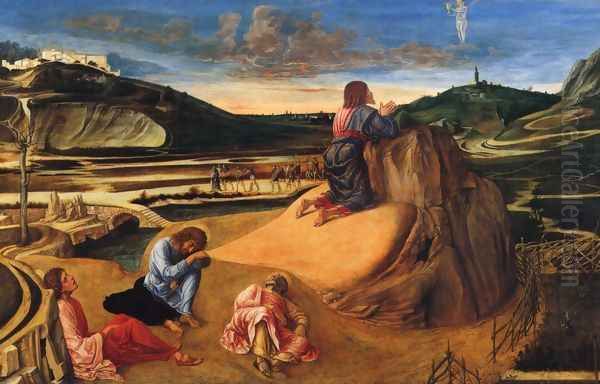
A crucial figure in Giovanni Bellini's early development was Andrea Mantegna, one of the leading figures of the North Italian Renaissance based primarily in Padua and later Mantua. The connection was personal as well as artistic: around 1453, Mantegna married Giovanni's sister, Nicolosia Bellini. This union fostered a close artistic dialogue between the two young painters.
Mantegna's art was characterized by its rigorous perspective, sharp linearity derived from Florentine principles (particularly Donatello, who worked in Padua), archaeological interest in classical antiquity, and often stark, sculptural forms. In his early works, Giovanni Bellini clearly absorbed elements of Mantegna's style. Paintings like the Agony in the Garden (National Gallery, London), which directly parallels a version by Mantegna, showcase this influence through their rocky landscapes, dramatic foreshortening, and somewhat sharp definition of forms.
However, even in these early exchanges, differences emerge. Bellini's version of the Agony possesses a softer light and a greater sensitivity to the dawning atmosphere, hinting at the direction his art would take. Over time, while maintaining respect for Mantegna's intellectual rigor, Bellini moved decisively away from his brother-in-law's sometimes harsh linearity. He sought a greater fusion of figure and landscape, a more nuanced rendering of light, and a deeper exploration of color's emotional potential, paving the way for the distinctive character of Venetian painting.
The Revolution of Oil Paint and Antonello da Messina
A transformative moment for Giovanni Bellini, and indeed for Venetian painting as a whole, was the adoption and mastery of the oil painting technique. While tempera (pigment mixed with egg yolk) had been the dominant medium, oil paint (pigment mixed with linseed or other oils) offered new possibilities. It allowed for slower drying times, enabling subtle blending, layering of translucent glazes, deeper and more luminous colors, and richer atmospheric effects.
The arrival of the Sicilian painter Antonello da Messina in Venice in 1475-1476 is often cited as a catalyst for the widespread adoption of oil techniques in the city. Antonello had likely learned the Netherlandish method, perhaps indirectly, and brought with him a sophisticated understanding of its potential, particularly in rendering light, texture, and volume with remarkable realism, as seen in his portraits and works like the St. Jerome in His Study.
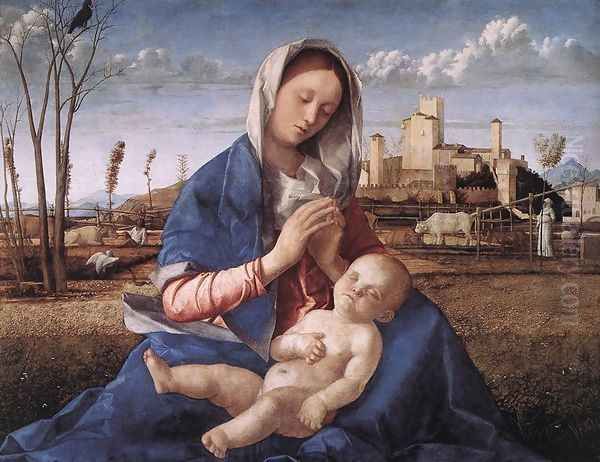
Bellini rapidly embraced the oil medium, adapting it to his own artistic temperament. He didn't simply mimic Netherlandish precision but integrated the technique with Venetian traditions and his own burgeoning interest in light and color. He developed a method of applying thin layers of oil glaze over a tempera or oil underpainting, achieving unprecedented depth, softness, and luminosity. This technical mastery became a cornerstone of his mature style and a defining characteristic of the Venetian School he helped to found.
Mature Style: The Poetry of Light and Color
By the 1480s, Giovanni Bellini had reached full artistic maturity, developing a style renowned for its harmonious compositions, serene beauty, and profound emotional depth, all conveyed through a masterful handling of light and color. This emphasis on colorito (the application and blending of color) and atmospheric effects, as opposed to the Florentine emphasis on disegno (drawing and design), would become the hallmark of Venetian painting.
Bellini's figures became softer, less rigidly defined than in his earlier work, seeming to emerge naturally from the play of light and shadow. He achieved a remarkable sense of atmospheric perspective, where distant landscapes dissolve into hazy light, creating a feeling of infinite space and tranquility. His use of color was both rich and subtle, capable of conveying warmth, divinity, and tender human emotion. He perfected a soft, diffused light that bathes his scenes, unifying the figures and their settings.
This mature style is evident in numerous masterpieces. His depictions of the Madonna and Child, a recurring theme throughout his career, evolved from somewhat austere early versions to images of profound tenderness and humanity, often set against evocative landscapes. His large altarpieces, known as Sacra Conversazione (sacred conversations), arrange saints around the Virgin and Child in harmonious, architecturally defined spaces, bathed in a gentle, unifying light that invites contemplation.
Major Themes and Representative Works
Giovanni Bellini's vast output encompassed a range of subjects, though religious themes remained central throughout his long career.
Madonna and Child: This was perhaps Bellini's most frequent subject. He produced countless variations, from half-length figures for private devotion to central figures in large altarpieces. Works like the Madonna of the Meadow (National Gallery, London) or the Madonna degli Alberetti (Madonna of the Small Trees, Gallerie dell'Accademia, Venice) exemplify his ability to infuse this traditional theme with warmth, naturalism, and poetic landscape settings.
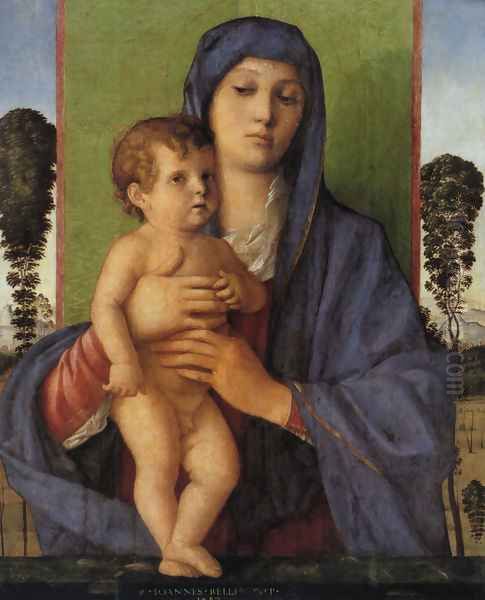
Pietà: Bellini explored the theme of the dead Christ supported by the Virgin Mary and St. John (or angels) with profound pathos. Early versions, like the Pietà in the Pinacoteca di Brera, Milan, show Mantegna's influence in their expressive intensity and sharp forms. Later versions become softer, emphasizing grief through subtle expressions and the tender handling of paint.
Sacra Conversazione: Bellini was instrumental in developing this typically Venetian altarpiece format. Masterpieces like the San Giobbe Altarpiece (c. 1487, Gallerie dell'Accademia, Venice) and the San Zaccaria Altarpiece (1505, Church of San Zaccaria, Venice) are pinnacles of the genre. They depict the Virgin and Child enthroned, surrounded by saints, within a unified, light-filled architectural space that often seems like an extension of the church itself. These works are celebrated for their serene grandeur, harmonious color, and masterful rendering of light.
St. Francis in Ecstasy (or St. Francis in the Desert): This iconic painting (c. 1480, Frick Collection, New York) is one of Bellini's most celebrated and enigmatic works. It depicts St. Francis standing in a meticulously detailed landscape, bathed in a golden, divine light emanating from the upper left. The precise meaning – whether Francis is receiving the stigmata or experiencing a mystical union with nature – remains debated, but the painting is a tour-de-force of landscape painting, detailed observation, and the depiction of spiritual transcendence through light and nature.
Portraits: While perhaps less numerous than his religious works, Bellini produced striking portraits. The Portrait of Doge Leonardo Loredan (c. 1501, National Gallery, London) is a masterpiece of Renaissance portraiture, capturing both the sitter's likeness and the dignity of his office with remarkable realism and subtle characterization, achieved through the sophisticated use of oil glazes.
Mythological and Allegorical Subjects: Later in his career, Bellini turned occasionally to mythological themes, often incorporating his signature landscape style. The most famous example is The Feast of the Gods (1514, National Gallery of Art, Washington D.C.). Commissioned by Alfonso d'Este for his studiolo in Ferrara, this painting depicts classical deities feasting in a lush woodland setting. It represents a significant engagement with classical themes, rendered with Bellini's characteristic sensitivity to color and atmosphere.
The Bellini Workshop and a Legacy of Students
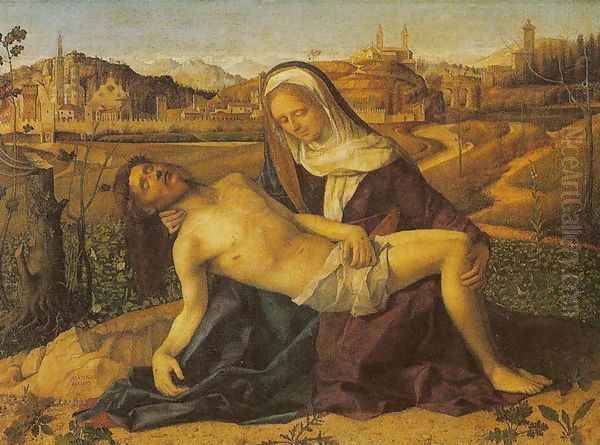
Giovanni Bellini presided over a large and highly successful workshop, which became the preeminent training ground for the next generation of Venetian masters. His influence extended not only through his finished works but also through his direct teaching and the collaborative environment of his studio. He instilled in his pupils his technical mastery, particularly of the oil medium, and his profound understanding of color and light.
Two of his students rose to become giants of the High Renaissance:
Giorgione (Giorgio Barbarelli da Castelfranco): Though his career was tragically short, Giorgione absorbed Bellini's sensitivity to landscape, mood, and color, developing it into a highly personal, enigmatic style known as pittura di poesia (poetic painting). Works like The Tempest show a clear debt to Bellini's atmospheric landscapes, but push the ambiguity of subject matter and the dominance of mood even further.
Titian (Tiziano Vecellio): Arguably the greatest painter of the Venetian School, Titian spent time in Bellini's workshop (possibly after initial training with Gentile or another master). He inherited Bellini's command of color and oil technique but infused it with greater dynamism, dramatic intensity, and psychological depth. Titian would build upon Bellini's foundations to dominate Venetian painting for decades, achieving international fame. He even completed Bellini's final major work, The Feast of the Gods, altering the landscape after Bellini's death.
Beyond these two luminaries, many other significant artists were influenced by or passed through Bellini's circle, including:
Vittore Carpaccio: Known for his detailed narrative cycles for the Venetian Scuole, showing an affinity for observation, though with a different sensibility than Bellini.
Cima da Conegliano: Developed a clear, tranquil style heavily indebted to Bellini's compositions and landscape treatments.
Marco Basaiti: A collaborator and follower whose style closely mirrors Bellini's later work.
Vincenzo Catena: Another follower whose works often echo Bellini's compositions and figure types.
Palma Vecchio (Jacopo Palma the Elder): Known for his idealized female figures and rich coloring, showing the Bellini legacy as absorbed through Giorgione and Titian.
Bartolomeo Montagna: Active in Vicenza, he absorbed influences from both Mantegna and Bellini.
Lorenzo Lotto: A highly individualistic painter who likely had contact with Bellini's workshop early in his career.
Even the great German master Albrecht Dürer, during his visits to Venice, expressed immense admiration for Giovanni Bellini, considering him the finest painter in the city, despite Bellini's advanced age at the time. This highlights Bellini's enduring reputation and influence.
Later Years, Death, and Enduring Influence
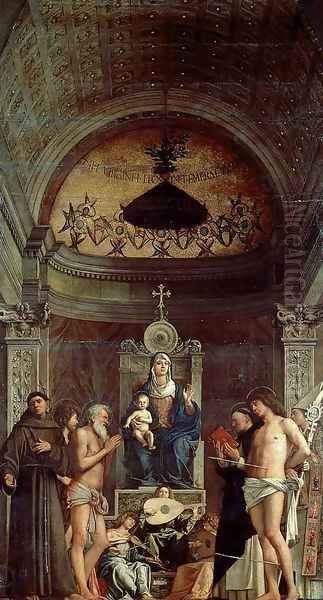
Giovanni Bellini remained artistically active into his eighties, a testament to his enduring creativity and physical stamina. His late works, such as the San Zaccaria Altarpiece (1505), the Madonna and Child in the Detroit Institute of Arts (1509), and The Feast of the Gods (begun 1514), show no decline in quality. Indeed, they demonstrate a continued refinement of his technique, a mastery of harmonious composition, and a serene, almost timeless quality.
The Feast of the Gods, although completed and altered by Titian, reveals Bellini's late engagement with classical mythology, rendered with the same sensitivity to landscape and light that characterized his religious works. His willingness to tackle new themes even in old age speaks to his artistic vitality.
Giovanni Bellini died in Venice in November 1516, likely in his mid-80s. He was buried alongside his brother Gentile in the prestigious Basilica di Santi Giovanni e Paolo (often known by its Venetian dialect name, San Zanipolo), the traditional resting place of Venice's Doges and other prominent citizens – a mark of the high esteem in which he was held.
His influence was immediate and profound. He had effectively transformed Venetian painting, establishing oil paint as the primary medium and colorito and atmospheric light as its defining characteristics. He elevated landscape from mere background to an integral, expressive element of the composition. He imbued religious painting with a new level of human emotion and accessibility. Through his workshop, he trained the artists who would carry the Venetian Renaissance to its zenith. Bellini's legacy lies not just in his own magnificent body of work but in the entire subsequent course of Venetian art, which, thanks largely to his innovations, would stand alongside Florence and Rome as one of the great centers of Renaissance painting.
Anecdotes and Unresolved Questions
Despite his fame, certain aspects of Bellini's life remain shrouded in some mystery, giving rise to anecdotes and scholarly debate.
The Unfinished Feast: The story of The Feast of the Gods being left unfinished at Bellini's death and completed by his brilliant student Titian is well-documented through letters and technical analysis. X-rays reveal Bellini's original landscape composition beneath Titian's more dramatic, dynamic revisions. This collaboration across generations highlights the transition occurring in Venetian art at the time of Bellini's passing.

The Mystery of St. Francis: The precise iconography and meaning of St. Francis in Ecstasy continue to be debated by art historians. Is he receiving the stigmata (which are not explicitly visible)? Is he communing with God through nature, symbolized by the divine light? The painting's rich detail, from the meticulously rendered plants to the distant city, invites multiple interpretations, adding to its enduring fascination.
Birth Date and Place: While traditionally believed to have been born around 1430-31 in Venice, some scholars have questioned this, suggesting an earlier birth date or even birth in Padua, given the family's connections there. The lack of definitive documentation leaves room for speculation.
Mantegna Rivalry?: While the artistic exchange with Mantegna is clear, the personal dynamic remains intriguing. Vasari, the 16th-century biographer, hints at a degree of rivalry. Whether their differing artistic paths – Mantegna's intellectual classicism versus Bellini's sensual colorism – reflected personal tensions or simply divergent artistic evolution is difficult to ascertain.
Giovanni Bellini's long life spanned a period of immense artistic change. He was not merely a witness but a prime mover, a quiet revolutionary whose dedication to his craft, his embrace of new techniques, and his profound sensitivity to the visual world created a legacy that continues to inspire awe. His paintings offer a unique blend of spiritual depth and sensuous beauty, securing his place as one of the indispensable masters of the Italian Renaissance.